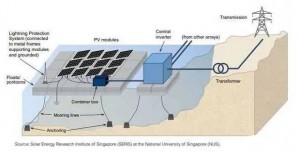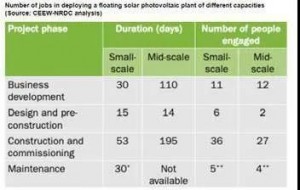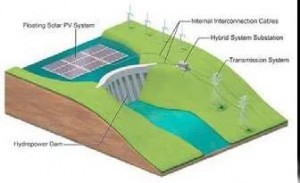A decade ago, solar was a marginal renewable energy source. In just 10 years, solar power has become a superior option. Now, it’s time to consider the rise of floating pv. Think about it. Before 2013, floating photovoltaic cells didn’t even exist.
The first patent for floating PV was filed in 2008. In 2006, floating photovoltaic specialist Ciel et Terre, based in Lille, France, began pushing the idea.
In 2007, a small 175KW commercial power station was built on a pond in Far Niente, a Napa Valle wine producer, to reduce energy costs and avoid land grabs. Higher profits can be made by planting vines on the land.
The first formal floating PV system was built in Aichi Prefecture, Japan, in 2007. Since then, many countries have seen the emergence of small plants below the megawatt level, particularly in France, Italy, South Korea, Spain and the United States, which are used primarily for research and demonstration. Keep in mind that even the “Normal”cost of solar energy can not be sustained during this period and can only be achieved with generous feed-in tariffs and direct subsidies.
So far, it is clear that Asia will dominate the floating PV in the near future and beyond.
We chose floating PV because the news about this new field has not stopped since last month. The first is that NTPC has commissioned a 10MW floating photovoltaic power station in the NTPC’s Simhadari Thermal Power Plant Reservoir. The plant easily became India’s largest in the field, but not for long. Then Ciel Et Terre inaugurated the 5.4 MW station at Sagardighi in West Bengal, the first of its kind at a thermal power plant.
That’s not all. By the time you read this story, NTPC may have inaugurated another of India’s largest floating PV plants, the 100 MW floating PV power plant planned for the first phase at the Telangana. Construction of the project was originally scheduled to start in May, but due to the new crown disease, it will now be started in stages, each stage about 15MW, and the whole 100MW project will be completed by the end of this year.
The 4.23 billion Indian Rupee project will eventually cover water bodies or reservoirs serving the Ramagundam Thermal Power Plant. The cost of floating PV is also falling steadily, with a bid of RS3.29 kWh for a 150MW floating PV project at Ridam Hand Reservoir in Uttar Pradesh state, won by Shapoorji Palonji Rup and Renew Power. (note: the project has been delayed due to terrain-related problems).
Not only that, but a 60MW power station has been put into operation worldwide in Singapore. It is one of the largest floating power stations in the world and was built on a reservoir by a subsidiary of Sembcorp Industries on an area of 45 hectares (111 acres) . On the nearby island of Batam in Indonesia, singapore-based SUNSEAP has also announced plans to invest more than $2 billion in another 2.3 GW Solar + storage plant.

In a march report, Market intelligence firm Transparency Market Research (T) predicted strong growth in 2027, with a compound annual growth rate of 43% . Talso expects that innovation and technological progress will ensure that the growth momentum of floating PV does not slow. Increased adoption of floating PV modules in developing countries such as India and China will further drive growth. Nearly 40 of the more than 63 countries that have announced floating PV projects already have one in operation or close to it.
Today, the actual installed capacity of floating PV is close to 3 GW, while the total installed capacity of solar energy is close to 775 GW. As the cost of solar power continues to fall with increasing scale and greater understanding of technology, floating PV is no longer an option for the future, and the age of floating PV has arrived.
Why floating pv?
The basic advantages of floating PV are well known. Progress can be seen in areas of high population density, particularly where competition for available land is intense. The East India is a case in point. Linking floating PV to large reservoirs built for hydropower can bring floating PV close to existing power transmission infrastructure or to demand centres such as water treatment plants, another advantage that drives the development of floating pv.
Because of the cooling effect of water and the reduction of dust, floating PV projects have obvious advantages in increasing energy output. On a 25-year life expectancy basis, these advantages help close the gap with the initial cost of solar energy on the ground, which typically accounts for 10-15 per cent of the cost.
Simply put, floating PV makes up for solar’s unmet energy needs. In some places, in order to install the ground solar energy, need to obtain a lot of land, this is a problem. Power generation can be made more efficient by combining it with existing resources, such as thermal power plants or hydroelectric plants.
In the case of hydroelectric power stations, the reservoir can reduce hydroelectric power during the peak hours of the day, when solar power comes into play. The first of its kind was built in Portugal in 2017 and was installed by EDP. Since output growth is predictable, the feedback so far has been positive. It also means greater grid stability and reliability in terms of scale.

The National Renewable Energy Laboratory (NREL) estimates that there are nearly 380,000 freshwater reservoirs around the world with the potential to combine floating photovoltaic and existing hydropower facilities. Of course, a comprehensive analysis may reveal some reservoirs that are not suitable due to a variety of problems, such as low water levels and even reservoirs that do not store water during the dry season. But there is no doubt that finding the area for the construction project is not a problem at all. The potential power generation capacity is almost 7TW, which is not to be underestimated.
The challenge of floating pv
Of all the challenges of floating PV, the biggest is likely to be who will support it, whether it’s cost, technology or financing. Ground-based solar power stations receive a lot of subsidies, feed-in tariffs and more. But the same “Start-up”benefits can not be achieved by floating PV except by relying on the private sector to operate. The good news is that the technology is catching up fast, and key issues like cost differentials are already moving in a manageable direction.
Quality problem
As far as its nature is concerned, floating PV requires more attention in design and construction. As Ushadevi asserts, the main difference is that in other developed countries, the choice is based purely on technical credentials, financability and reputation. In India, Price is the main factor. Indian developers and EPC companies should be very cautious in their choice of technology. To reduce risk, developers should focus on finding high-quality raw materials, first-class UV stabilizers, high-quality machines for producing high-quality floaters, quality assurance inspections, processes, design testing and validation, and obtaining reliable solutions.”
The system cost of floating PV has increased by 10-15% , mainly from the floating structures, anchoring and mooring systems required for the floating system. Development costs are already falling. Floating systems present specific challenges related to anchoring and mooring, with possible changes in water levels, reservoir bed types, depth and extreme weather conditions such as strong winds and waves adding to engineering and construction costs.
Proximity to water also means paying more attention to cable management and insulation testing than on land, especially when the cable comes into contact with water. Another factor is the constant frictional and mechanical pressure on the moving parts of the floating PV plant. A poorly designed and maintained system can fail catastrophically. Flotation devices are also at risk of failure and corrosion from moisture, especially in more aggressive coastal environments. PV modules capable of operating in harsh environments for 25 years should be selected using appropriate quality standards. The role of anchoring is to spread the load of wind and waves, minimize the movement of the solar island, and avoid the risk of hitting the shore or being blown away in a storm. Extensive technical studies are required to assess the appropriate island and anchor design, overall technical feasibility and commercial viability of the project.

Long-term prediction
NREL estimates that there are 379068 freshwater hydroelectric reservoirs around the world that could accommodate floating photovoltaic plants alongside existing ones. Some reservoirs may be dry for part of the year, or otherwise unsuitable for floating PV, so more site selection data is needed before the project can be implemented. The greatest benefit of floating PV is that it does not take up valuable land space, which is of increasing importance to India. We have seen projects affected by land conflicts between solar power plants and issues related to grazing lands and the habitat of the great bustard in India. When it comes to the construction of floating photovoltaic units on hydropower project reservoirs, the increased capacity may actually help to avoid some of the problems of planned hydropower projects. One example is the Tapovan project in the Chamoli district of NTPC in Uttarakhand, which recently suffered extensive damage as a result of flash floods. The project is more than 10 years behind schedule, costs more than five times the original estimate, and the planned river project could easily generate electricity through the company’s many floating photovoltaic projects in the transportation reservoir.
Ushadevi of Ciel Et Terre asserts: ‘because of the scarcity of land, the legal issues and disputes of land expropriation and the infinite delay of expropriation, floating PV is the perfect solution. Given the scarcity of water, the evaporation of water, the land problem, and the positive side of having a lot of water available, we are pretty sure that India’s demand for floating PV has finally arrived. We believe floating solutions will be one of the main driving forces in the PV industry and we aim to develop 1GW Hydrelio technology solutions in India in the next 2-3 years.”
To illustrate his point, he cites the example of West Bengal. “In the past, we have looked at a lot of projects in the West Bengal and thought that the West Bengal has great potential to develop photovoltaic projects. There are many types of water bodies in the West Bengal, including dams, irrigation or water treatment ponds. These are ideal for floating projects. The same is true in Kerala, where there is a lot of water.”
So far, all the projects have been built on fresh water or on captive ponds, but that doesn’t mean it’s impossible in the ocean. Ciel Terre Taiwan recently launched 88MWP’s Changbin project, the largest such seawater project. This requires the company to partner with the Principia. Principia is a head offshore company that develops and implements cost-effective solutions and integrated wind and wave designs.
It is worth noting that even the most active participants have long called for these plants not to be built on natural lakes and other bodies of water. The companies say not to take risks without long-term experience of floating PV, which could have an impact on the project. At the same time, we should avoid conflicts with fishermen’s livelihood. Covering natural ponds with flotsam means there is less sunlight available for algae to grow, which reduces algal blooms. Evaporation is expected to decrease as a large portion of the water body will be covered or obscured by floating photovoltaic plants. Light and heat are expected to decrease, and the reservoir’s aquatic life needs a new balance. We prefer to use man-made water because it has less impact on aquatic life.
Conclusion
If you take into account the years of large-scale power plants built using this technology, floating PV has come a long way in a very short time. That means we need to be cautious before making big assumptions and predictions, but it looks like a solution that could fill an important gap in solar power generation. It would also save land and even allow the reservoir to provide more revenue. While many hydropower projects cost more than 3.5 rupees per kWh, or even more than 6 rupees per kWh, there are good reasons to argue against floating PV because of its cost.
Concentrate on learning from the initial successes of floating PV, which may be less damaging to the environment than hydropower, which, frankly, has underperformed in India in recent years. Rooftop Solar, though heavily subsidized, does not work well. Like mainstream solar, governments need to make sure that floating PV doesn’t go the way of rooftop solar. In order to ensure real progress in the project, the lack of depth assessments of water bodies, topographic bathymetric data and other technical and environmental problems need to be urgently addressed. One example is the fate of the Rihand Large Dam project, which ran into trouble because of limited knowledge of the terrain and a lack of information.
Floating PV also provides a real opportunity to install some really important solar projects in all Indian states, particularly in eastern India.



 2021-08-06
2021-08-06

















